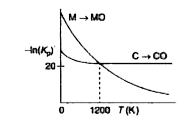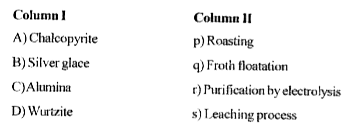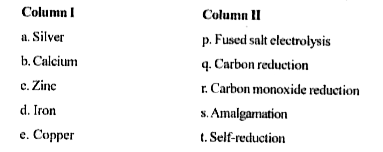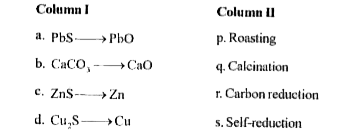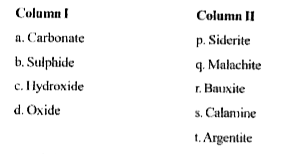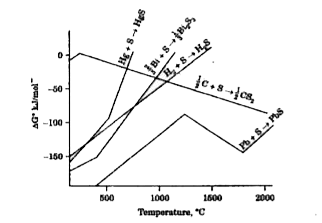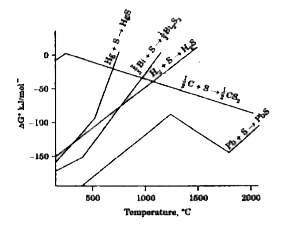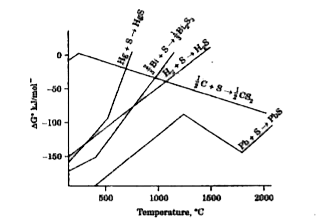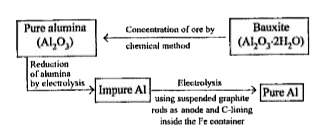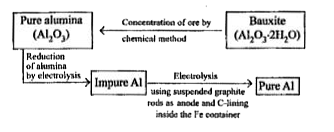LEVEL-III (Linked Comprehension type) from BRILLIANT PUBLICATION GENERAL PRINCIPLES AND PROCESSES OF ISOLATION OF ELEMENTS for Class 12
| Class 12 | CHEMISTRY |
| Chapter | GENERAL PRINCIPLES AND PROCESSES OF ISOLATION OF ELEMENTS |
| BRILLIANT PUBLICATION | LEVEL-III (Linked Comprehension type) |
| Medium | English |
| Academic Year | 2023-2024 |
Question 37
Assertion : At temperature above 1073 K (approx.) the C,CO line comes below the Fe,FeO line [ΔGCCO<ΔGFeFeO]
Reason : In this range, coke will reduce the FeO and itself get oxidised to CO. : If both (A) and (R) are correct and (R) is the correct explanation of(A)., If both (A) and (R) are correct, but (R) is not the correct explanation of (A)., If (A) is correct, but (R) is incorrect., If both (A) and (R) are incorrect. View SolutionQuestion 43
The heating process for the extraction of elements are quite old but highly acceptable method for the extraction of elements. Because in this process the elements produced is in the highly pure state. Mostly As,Sb,N2Ni,Zr,B etc are prepared by this principle.
A number of metal sulphide uses which may be roasted first in air to partially convert them to the oxide, and then further roasted in the absence of air, causing self reduction.
View SolutionQuestion 44
Copper is most noble of the first row transition metals and occurs in small deposits in several countries.Ores of copper include chalcanthite (CuSO4,5H2O) atacamite (Cu2Cl(OH)3), cuprite (Cu2O), copper glance (Cu2S) and malachite (Cu2(OH)3CO3). However, 80% of the world copper production comes from chalcopyrite (CuFeS2). The extraction fo copper from chalcopyrite involves partial roasting, removal of iron and self reduction.
Iron is removed from chalcopyrite as View SolutionQuestion 45
Copper is most noble of the first row transition metals and occurs in small deposits in several countries.Ores of copper include chalcanthite (CuSO4,5H2O) atacamite (Cu2Cl(OH)3), cuprite (Cu2O), copper glance (Cu2S) and malachite (Cu2(OH)3CO3). However, 80% of the world copper production comes from chalcopyrite (CuFeS2). The extraction fo copper from chalcopyrite involves partial roasting, removal of iron and self reduction.
Iron is removed from chalcopyrite as View SolutionQuestion 46
Copper is most noble of the first row transition metals and occurs in small deposits in several countries.Ores of copper include chalcanthite (CuSO4,5H2O) atacamite (Cu2Cl(OH)3), cuprite (Cu2O), copper glance (Cu2S) and malachite (Cu2(OH)3CO3). However, 80% of the world copper production comes from chalcopyrite (CuFeS2). The extraction fo copper from chalcopyrite involves partial roasting, removal of iron and self reduction.
In self reduction , the reducing agent is View Solution
All Exercises from BRILLIANT PUBLICATION Class 12 CHEMISTRY GENERAL PRINCIPLES AND PROCESSES OF ISOLATION OF ELEMENTS
- (LEVEL - I)
- LEVEL - I (HOMEWORK)
- LEVEL - I (HOMEWORK) (ASSERTION - REASON)
- LEVEL-I
- (LEVEL - II)
- (LEVEL - II) ASSERTION - REASON TYPE
- LEVEL - II
- LEVEL - II (ASSERTION - REASON)
- LEVEL-II
- LEVEL-III (LINKED COMPREHENSION TYPE)
- LEVEL-III (MATCHING COLUMN TYPE)
- LEVEL-III (MULTIPLE CORRECT ANSWER TYPE)
- LEVEL-III (NUMERICAL TYPE)
- LEVEL-III (SINGLE CORRECT ANSWER TYPE)
- LEVEL-III (STATEMENT TYPE)
